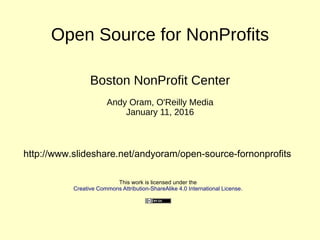Open Source for Nonprofits
- 1. Open Source for NonProfits Boston NonProfit Center Andy Oram, O'Reilly Media January 11, 2016 This work is licensed under the Creative Commons Attribution-ShareAlike 4.0 International License. http://www.slideshare.net/andyoram/open-source-fornonprofits
- 2. Why Open Source? (Part 1: Data) Andy Oram, O'Reilly Media January 11, 2016 The world depends on data Software can help you derive important organizational insights from data : And so does your organization Which of your outreach efforts are most successful, and with whom? Where are your clients coming from, and where should you expand your service? Where is your spending producing the most benefit? What do trends from the past few years suggest for the future?
- 3. Why Open Source? (Part 2: Needs) Andy Oram, O'Reilly Media January 11, 2016 Different pieces of software tend to work together better when they are open source To store, share, manage, and process this data, you need software that: Costs as little as possible (hopefully nothing) Is open to inspection Is guaranteed not to go away Comes with a community who understands it
- 4. What is Open Source? Andy Oram, O'Reilly Media January 11, 2016 Essentially a license Most importantly, a community (Is that what I need? Another community?) And finally, a promise: your software will always be available and can always be updated and maintained You are able to view, change, and share the source code
- 5. The alternative—beware Andy Oram, O'Reilly Media January 11, 2016 Vendors who raise prices precipitously Vendors who go out of business Vendors who strip out the feature you need most Vendors who suddenly remove access Vendors who are slow to fix bugs and security flaws Vendors who hold your data hostage Vendors who spy on you Vendors whose apps are infected with malware
- 6. Examples of free and open source software Andy Oram, O'Reilly Media January 11, 2016 Databases (MySQL, MariaDB, PostgreSQL) Contact relationship management (CiviCRM) Document and image preparation (OpenOffice, LibreOffice, Gimp) Software for educators, health care providers, etc.
- 7. Search for “education” on GitHub Andy Oram, O'Reilly Media January 11, 2016
- 8. Search for “healthcare” on GitHub Andy Oram, O'Reilly Media January 11, 2016
- 9. Assessing Maturity—Models Andy Oram, O'Reilly Media January 11, 2016 If you want software you can depend on, look beyond features and robustness to assess the community and services around the software A huge number of rating systems and tools claim to determine maturity A typical system, the Open Source Maturity Model, rates product software, support, documentation, training, product integrations, and professional services
- 10. Assessing Maturity—One Essential Andy Oram, O'Reilly Media January 11, 2016 My own top criterion (after features): how smoothly error reports are handled You can be almost 100% sure something will go wrong after you adopt the software Software comes “as is” with no warranty Participating individuals and companies determine priorities on their own You want to be treated with respect and receive attention promptly However, in open source, no one owes anyone a bug fix
- 11. Why do people participate? Andy Oram, O'Reilly Media January 11, 2016 Scratch your own itch (meet an immediate need) Derive enhancements and bug fixes from outsiders Ensure your software meets the community's needs Catapult to large-scale use Worked for Linux! Do these values resemble those of your organization? Honor a mission devoted to freedom and universal growth For instance, fits values of the education field and international development
- 12. Keys to benefitting from open source Andy Oram, O'Reilly Media January 11, 2016 Determine your own requirements in detail Research software for quality and maturity Become part of the community—engage with users and developers Give as well as take Promote the software and open source in general Community forums are the best source of support—not vendor staff












